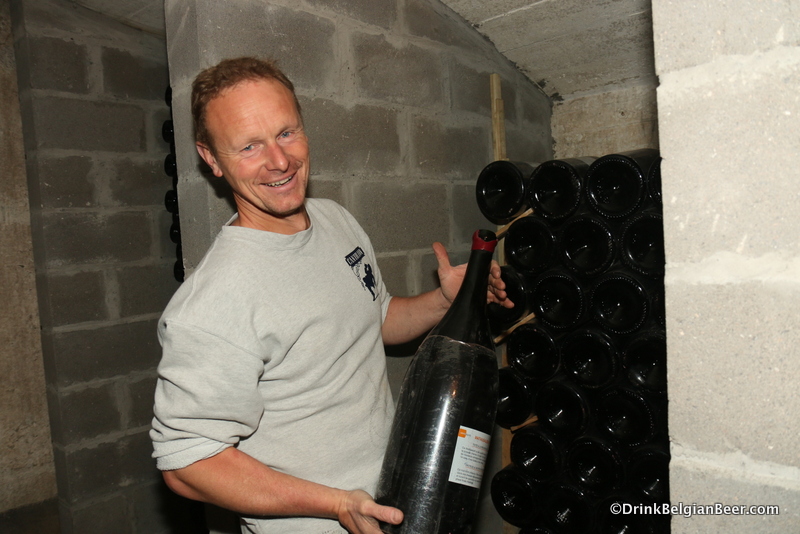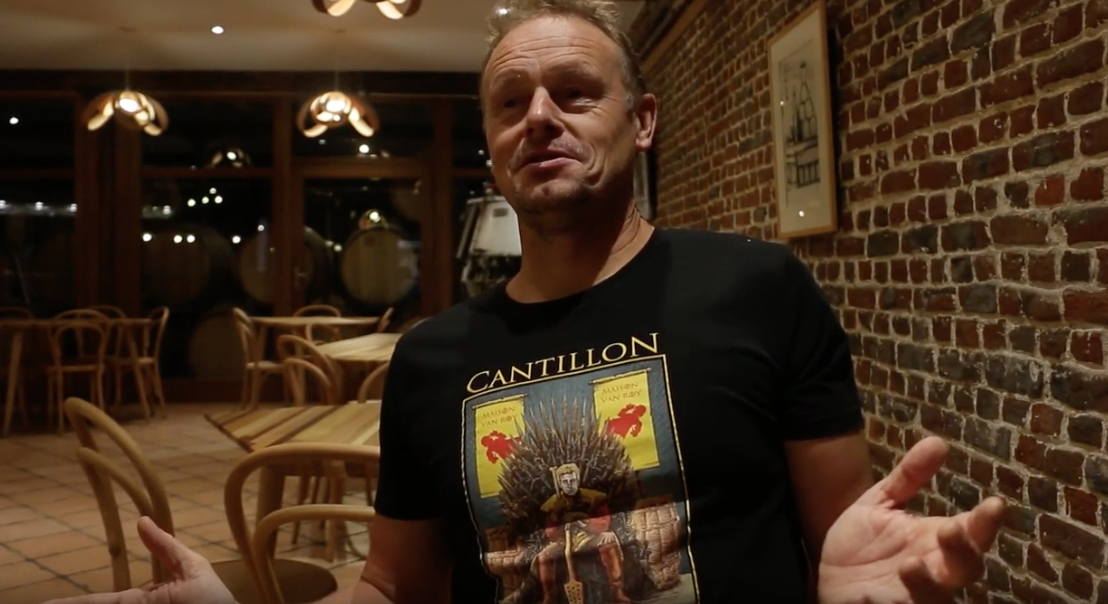In late August 2018, I interviewed Jean Van Roy, brewmaster and fifth generation owner of Brasserie Cantillon, which is perhaps the world’s most beloved lambic brewery. The interview took place just a couple of days after the third edition of the superb BXL Beer Festival in Brussels.
I asked Jean about a wide variety of topics. All, of course, were related to Brasserie Cantillon. The interview lasted about an hour, and is separated into five parts. There are five videos in chronological order, below.

Part 1: (below) Here, Jean Van Roy speaks about this first memories of the Cantillon brewery, as well as joining his father in the business in 1989. He talks about the slow but steady increase in lambic production in the 1990’s, beginning with his first or second lambic brewing season. Jean also covers how he and his father, Jean-Pierre Van Roy, started to see a growing interest in lambic beers in Denmark, Finland, Sweden, Japan, Italy, the U.S. in the early 2000’s. Jean remarked: “I officially started working with my father at Brasserie Cantillon on October 1, 1989. This was after I had finished with my service in the Belgian military. During my first lambic brewing season as a Cantillon employee, which was 1989-90, my father decided to increase the number of brews per year, from nine to twelve.”
He added: “To be specific about our production in those years, I can tell you that we pump about 75 hectoliters (hl) (about 64 U.S. barrels) of wort into our coolship each brew, and then we lose about 10 hl to evaporation as the hot wort cools overnight. We lose even more wort during the lambic maturation process in barrels, so our net from each brew day is about 56 hectoliters (about 48 U.S barrels) of lambic. This is the amount that we declare for excise (tax) purposes. So when my father was brewing nine times a year, the brewery was only producing about 500 hectoliters of lambic (about 426 U.S. barrels.)”
The increase to 12 brews a year brought the annual production to about 672 hl. Jean commented: “By the late 90’s, 1998 or so, we were brewing 15 to 18 times a year. So that was a level of lambic production between 850 and 1000 hectoliters per year.”
Part 2: (below) Brasserie Cantillon Brewmaster Jean Van Roy talks about an experiment with a couple of foeders (foudres) that Cantillon started using to age lambic with in 2016, and his opinions about using small barrels of 220 to 600 liters for maturing lambic. Jean also discusses the first time blending lambic on his own, as well as what his father, Jean-Pierre Van Roy, had to say about it. Jean additionally discusses the creation of St. Lamvinus in 1992, and Fou’ Foune in 1990. He also remarks about lambic brewing being closer to wine making than to brewing non-spontaneously fermented beers, and to his connections and many friends in the wine world, especially those in France and Italy. Jean discusses how he gathers inspiration for new beers, and also talks about the creation of Lambic d’ Aunis, which is produced using Pineau d’Aunis wine grapes from the Loire Valley in France. This discussion continues in part 3.
Part 3: (below) Cantillon brewmaster Jean Van Roy continues his remarks about using Pineau d’Aunis wine grapes from the Loire Valley in France with some lambics. The first beer released using these grapes was the Zwanze 2011 vintage, and later, Lambic d’ Aunis. Jean also discusses Menu Pineau, a lambic experiment produced using grapes of the same name from the Loire Valley region. Jean further talks about Vigneronne, and its predecessor, Druivenlambik/Cuvée Neuf Nations; Cantillon Framboise; and more about St. Lamvinus. He also talks about the history of Cantillon’s Open Brew Days, as well as the possibility that there could be a collaboration in Brussels in the future when all of the breweries and beer locations in the city (including Cantillon’s Bomb Shelter Beer Cellar) may be opened for a day. Jean also discusses how Cantillon has influenced the beer scene around the world, especially as regards to spontaneous fermentation. Jean also remarks about the need for a group or association of breweries producing spontaneously fermented beers.
Part 4: (below) Jean Van Roy talks about lambic brewing in Brussels, and how he would feel about other lambic breweries opening in the city, as well as the growing number of visitors that Cantillon receives every year. The brewery received 39,000 visitors in 2017. Additionally, he speaks about the idea his father, Jean-Pierre, has, of adding more space to the brewery museum. Brasserie Cantillon has many historical tools and others items used for lambic production in the past (with many that are not currently on display) as well as old documents related to the history of lambic, and Cantillon’s history. Jean also discusses other beer styles that he likes. These include pilsners, with the Italian-made Tipo Pils being a favorite, as well as saisons, and some fruited sours that are not made via spontaneous fermentation, but that are nevertheless great beers in their own right.

Jean also speaks about what he feels is one of his most interesting marriages of lambic and wine: La Vie est Belge, a collaboration with winemaker Stéphane Tissot of Domaine André et Mireille Tissot, in France. During a 2019 visit, Jean had this to say: “We used freshly emptied Vin Jaune wine barrels from France, with yeast and a small amount of wine still inside. We then filled them with wort from our coolship. The 2019 vintage of La Vie est Belge is a blend of lambic aged for two years in freshly emptied Vin Jaune barrels, and lambic aged for one year in freshly emptied Vin Jaune barrels.” For full details about La Vie est Belge, see this recent article. Jean also discusses what he drinks with friends at Royale Union Saint-Gilloise (Union SG) Football Club matches: before, during, and after the games.
Part 5: (below) Here, Jean Van Roy of Brasserie Cantillon talks in detail about Zwanze 2018, and the fact that he wanted to dedicate a Zwanze beer to Italy, because it was the first country outside of Belgium to really start to promote and defend traditional lambic. This started largely due to the efforts of lambic aficionado, author, and beer judge Lorenzo Dabove (aka “Kuaska”) who first visited Cantillon sometime in the mid-1980’s. “I first met Lorenzo sometime during my military service in the 1980’s. He told me that day that he had adopted my parents, so I was his brother. We still are brothers!” Jean remarked.
Here is Jean’s description of the 2018 Zwanze: “This years Zwanze is a result of blending three separate lambics that have been aged in Amarone, Chianti and Sangiovese red wine barrels from Italy. It is a fruity beer with notes of mango and citrus and a fine, lingering mouthfeel. It’s wine-like character is not only evident but accentuated by a slight woodiness.” Jean remarked that he thought the brew would have a strong, pronounced wine character, but that, in fact, it is very fruity and refined.
For all of you Cantillon fans (and lambic lovers) out there, I hope you have enjoyed what I think is a fascinating interview with one of the world’s most highly regarded brewmasters!


Leave a Reply